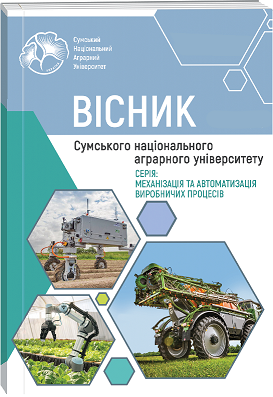RESEARCH OF FREE OSCILLATIONS OF THE BODY OF THE VEHICLE WHILE DRIVING
Abstract
Interest in the problems of strength and fatigue of rubber has increased significantly recently due to the wide implementation in practice of various products that carry large power loads. Therefore, numerous theoretical and experimental studies are devoted to the study of the effects of aging, fatigue and destruction of rubber. The material accumulated up to now, especially on certain issues, is so voluminous that its full presentation should be the subject of an independent presentation. The term “fatigue” is used to denote the determining factor of the type of failure in the form of an unexpected sudden division of a part or machine element into two or more parts as a result of the action of cyclic loads or deformations over a period of time. The destruction occurs by the initiation and propagation of a crack, which becomes its cause after reaching a certain critical size and becomes unstable and rapidly increases. The number of load cycles at which failure occurs depends on the level of the applied stress – as the variable stress increases, the number of cycles required for crack initiation and development decreases. In recently published monographs, a summary of many years of theoretical and experimental research on the problems of the strength of polymer bodies is summed up. Considerable attention is paid to rubber in these works. Irreversible mechanical and chemical changes may accumulate in rubber during long-term exposure to static or sign-changing loads. Such accumulation is usually called the fatigue process or fatigue, and the destruction of the sample as a result of its action – fatigue failure. During the long-term study of this process, specific terms were developed to characterize its individual elements. Thus, the working time of a part from the start of operation to failure is called durability, endurance or service life. Thus, the working time of a part from the start of operation to failure is called durability, endurance or service life. At the same time, the terms “fatigue limit” or “endurance limit” are also used, meaning the greatest stress that the sample can withstand, with an arbitrarily large number of load cycles.
References
2. Liu K., Zhang K., Shi X. Performance evaluation and modification mechanism analysis of asphalt binders modified by graphene oxide. Constr. Build. Mater. 2018. Vol. 163. P. 880–889. doi: 10.1016/j.conbuildmat.2017.12.171
3. Bockstal L., Berchem T., Schmetz Q., Richel A. Devulcanisation and reclaiming of tires and rubber by physical and chemical processes : a review. J. Clean. Prod. 2019. Vol. 236. P. 117574. doi: 10.1016/j.jclepro.2019.07.049
4. Aliha M.R.M., Shaker S. Effect of bitumen type, temperature and aging on mixed I/II fracture toughness of asphalt binders-experimental and theoretical assessment. Theor. Appl. Fract. Mech. 2020. Vol. 110. P. 102801. doi: 10.1016/j.tafmec.2020.102801
5. Mashaan N.S., Karim M.R., Mashaan N.S., Karim M.R. Waste tyre rubber in asphalt pavement modification. Waste tyre rubber in asphalt pavement modification. 2014. Vol. 8917. P. 5–9. doi: 10.1179/1432891714Z.000000000922
6. Amid S., Foroutan A., Dessouky S., Mork H., Kavussi A. The use of high content of fine crumb rubber in asphalt mixes using dry process. Constr. Build. Mater. 2019. Vol. 222. P. 643–653. doi: 10.1016/j.conbuildmat.2019.06.180
7. Wang T., Xiao F., Amirkhanian S., Huang W., Zheng M. A review on low temperature performances of rubberized asphalt materials. Constr. Build. Mater. 2017. Vol. 145. P. 483–505. doi: 10.1016/j.conbuildmat.2017.04.031

 ISSN
ISSN  ISSN
ISSN 



